Nothobranchius or notho killifish is an African freshwater ray-finned fishes genus of the Nothobranchiidae family of Cyprinodontiformes unit. These are the most bright-colored fishes among those that are kept in a tank. Their main distinctive feature is their unusual lifecycle, which is evolutionarily connected with the rain season arrival.
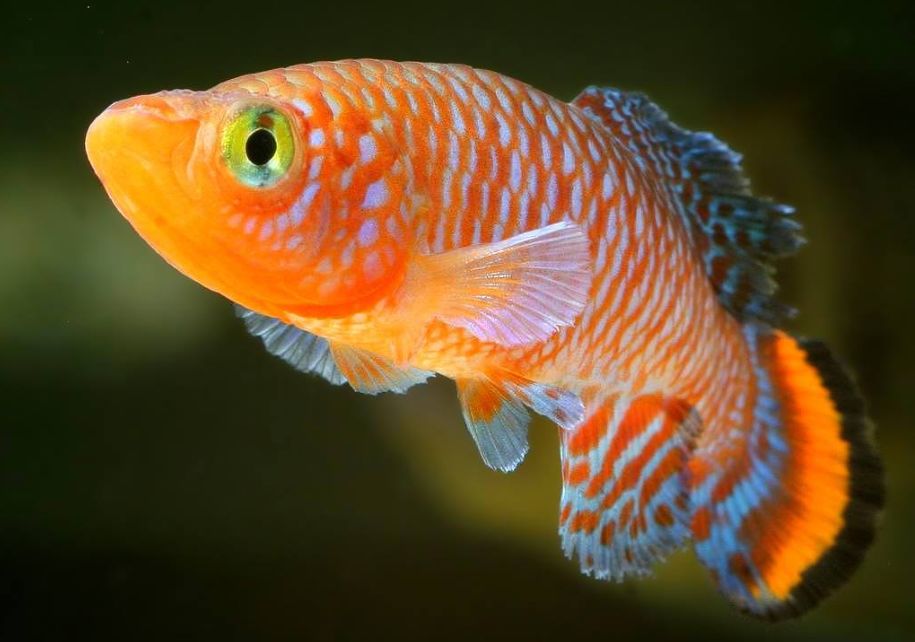
Contents
Habitat in the wild
According to various estimates, the Nothobranchiidae genus encounters from 30 to 60 notho killifish kinds that dwell in African waters. We observe such a scatter due to a large number of color variations existing in the wild. Besides, from time to time, some articles are published about the interspecies hybrids found.
The notho killifishhabitat stretches almost through all of Africa. Currently, the confirmed habitat of the kinds of Notobranchius genus includes North-South of The Republic of South Africa, areas of Namibia, Zambia, South-East of the Democratic Republic of the Congo, South-East part of Zimbabwe, Malawi, Mozambique, Tanzania, Kenya, Uganda, Somalia, South-East and South-West of Ethiopia, South of Sudan, South Sudan, Soth of Chad and North Cameroon.
One fish kind may have its habitat limited to just several square kilometers, while the other may occupy quite a large area. They have accustomed to live almost in all types of waters.
Tanzania is rich with these fish kind representatives. On its territory, you can encounter more than a third of all currently known notho killifish kinds. This is the country that supplied all new fish species for a long time, which then appeared in other countries.
The notho killifish habitats are usually located in hard-to-reach areas.
Comparatively thick populations are often isolated from each other and scattered over a quite large territory. This is how most fish coloring variations appear: from insufficient color differences to the absolutely different appearance of the same genus representatives.
The typical biotope of the notho killifish is usually small-sized shallow standing water. Quite often, it can be just a puddle, drain, or a bog in a river bottom-land, but not connected to it directly. There may be dozens of kilometers between them.
During the wet season, these are filled with water, and when the dry season comes, they get dry under the hot African sun. Water temperature in such ponds is rather stable within the ongoing season: it is 20-24°C during the rain season and 28-35°C in the dry season.
The bottom of such ponds is normally a mellow muddy-send substrate with a significant amount of organic inclusions rich in humic combinations, due to which the substrate has acidic pH. The water mineralization level is quite low.
Fishes that live in rivers can migrate to perennial deeper areas, while Nothobranchius dwelling in enclosed ephemeral impounded bodies that appear during the rainy season doesn’t have such a chance, and most of them die.
Nothobranchius are seasonal fishes in the literal sense of the word.
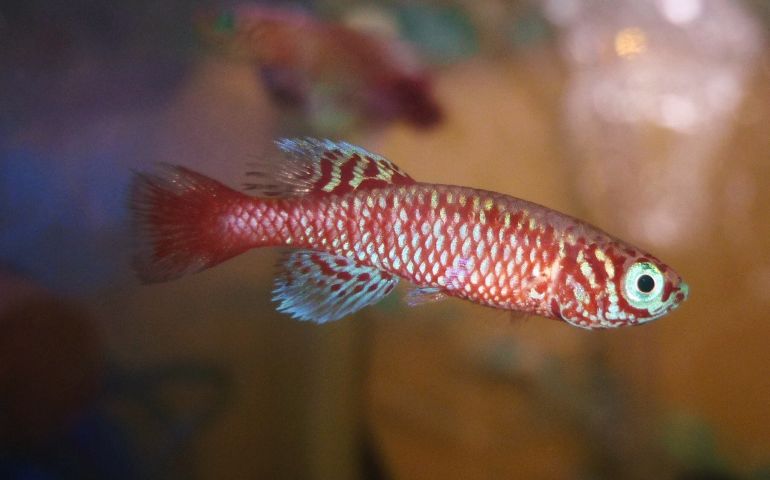
Eggs made of mud
As a result of evolution, the notho killifish has gained a specific survival mechanism. Nothobranchius main peculiarity is their unusual lifecycle evolutionary connected with the time when the rainy season comes.
As soon as the first raindrops start falling after the long dry season on the territory of Africa, almost in every puddle, you may see beautiful fish appear. They grow quite fast, and just a few months later, they start breeding.
They need to lay eggs as fast as possible while their pond still has water in it. Their eggs are rather endurant, and they can stay in dormancy or the so-called hibernation period for a long time. In such a state, they can survive without water for about 6 months or even a year.
How long they stay alive depends on the humidity and the surrounding air temperature. The eggs hibernation period length should be enough to survive various possible climatic disturbances such as the abnormally long absence of rains in the area.
For example, in some Sudan areas, heavy precipitation such as rain happens once in 4-5 years. The critical factor that influences hibernation period length is the temperature and humidity of the substrate where the eggs are.
Unfortunately, such an evolutionary adaptation contains an essential drawback for aquarists – as a result, fishes don’t live in a tank longer than a year.
Notho killifish Types
Bluefin notho (Nothobranchius rachovii)
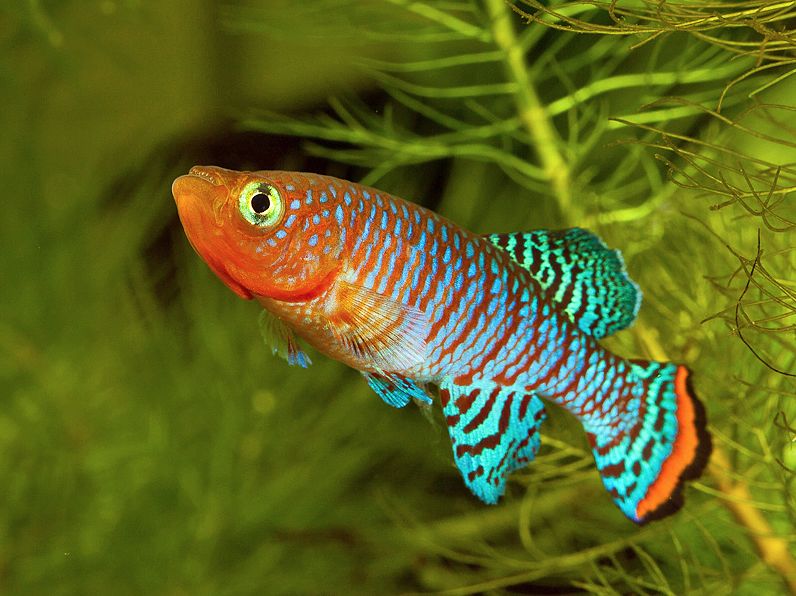
This is the most fascinating and bright representative of the kind. However, all abovementioned is true only for males.
The fish habitat is in Zambezi and Pangve River basins in Mozambique and waters in North-East of Africa. In the wild, bluefin notho length is about 8 cm, though this is true for the males since females are significantly smaller. The males are rather bright-colored.
They have a brick-red body, which grades to light blue closer to the fish tail fin.
Gunther’s Killifish (Nothobranchius guentheri)
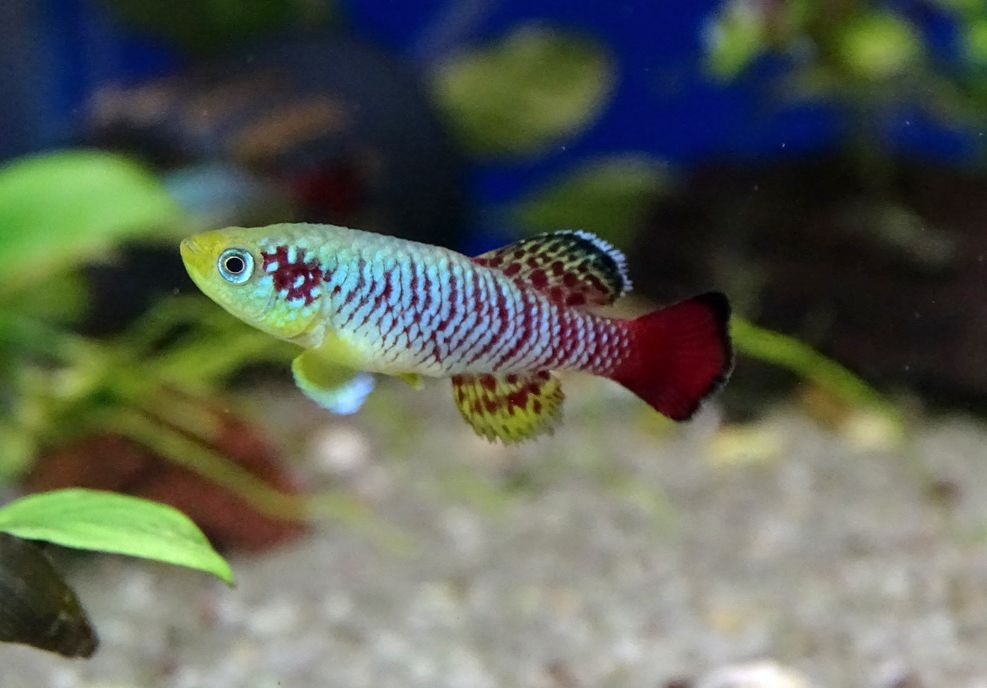
This kind inhabits in ephemeral waters of Kenya, Tanzania, and Mozambique. In tanks, it grows to be about 708 cm long.
The basic color of the fish body is light blue or greenish with many red spots and lines that become more intense near the fish tail. Pectoral and abdominal fins are light blue, while anal and dorsal fins color is dark red grading to blue. The tail fin has black outside edges.
The females of this kind have light-brown coloring and transparent fins.
Egger’s Killifish (Nothobranchius eggersi)
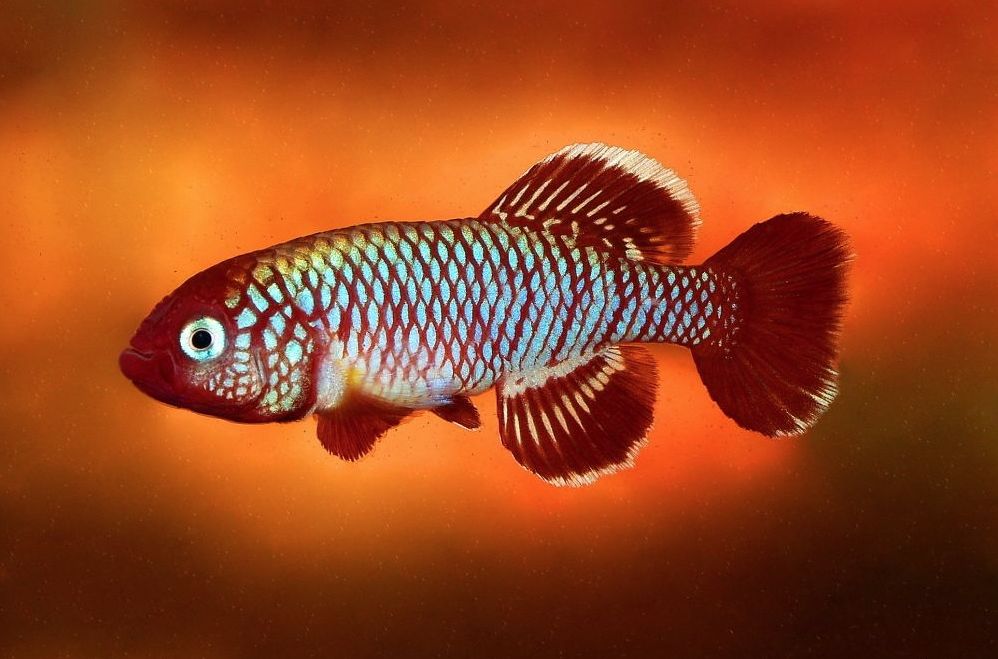
These are tiny fishes with large wide fins. Their anal and dorsal fins are shifted closer to the tail and form something like a fan. The main thing that attracts attention is their coloring.
On sale there are several fish kinds which you can keep in a tank. They are marked as ‘red’ and ‘blue.’ These are two main colors that are always present in the fish coloring, and one of them prevails.
Keeping in a tank
The fish’s unpretentiousness in terms of tank conditions is of great significance since due to this, it is extremely popular among aquarists. The vast majority of Nothobranchius kinds don’t require extremely soft and acidic water.
They are quite ok with tap water, and it will do both for keeping and breeding them. This fact allows aquarists to get rid of many troubles when preparing a tank for notho killifish.
Due to the fish’s small size, they don’t require large-capacity tanks. The minimum water amount for one fish is about 2-3 liters, at that the total tank capacity is just 1-15 liters. Thus Nothobranchius is a good choice for beginner aquarists who, due to various reasons, can’t get a large tank or they are fond of nano tanks.
Keeping Nothobranchius in a tank is normally smooth sailing. However, to make sure that several generations of the notho killifish will survive requires creating optimal tank conditions.
In the wild, they have to live in the temperature range from 16 to 32 °C with diurnal variability up to 6°C.
In captivity, the optimal temperature for them is within the range of 20—23°C. Since at lower temperatures, males’ coloring starts fading, and their appearance becomes less appealing. At higher temperatures, the notho killifish lifespan shortens while it’s not high in general.
Tank water hardness (dGH) may be from 5 to 20°. Water acidity (pH) may vary within the range from 6 to 7,5. Taking care of the tank is simple: keep it clean and perform weekly water renews.
Some kinds don’t like it when you renew an essential amount of tank water simultaneously. That’s why the new water should be close to the old one in terms of chemical composition. It is recommended to perform water renews in small portions since this will improve the tank dwellers’ appetite and health.
The notho killifish is rather timid; however, they can get on well with other not large and peaceful fishes. Ideally, some oviparous killifish that dwell in middle and upper water layers may be their tank mates.
Nothobranchius don’t like bright light, so it’s better to make it dim with the help of fluctuant on the tank water surface.
As for tank plants, we’d recommend the ones that can do living in dim light. For example, these can be java moss, Christmas moss, Java fern, some cryptocorynes kinds.
Nothobranchius’s appearance is the most spectacular in a thickly planted tank at the tank water temperature 21— 24°C.
At such conditions, the males grow to their maximum size and get their brightest coloring. Although in the wild, the notho killifish lives only for one season (about six months), in a tank, some species can live up to three years long.
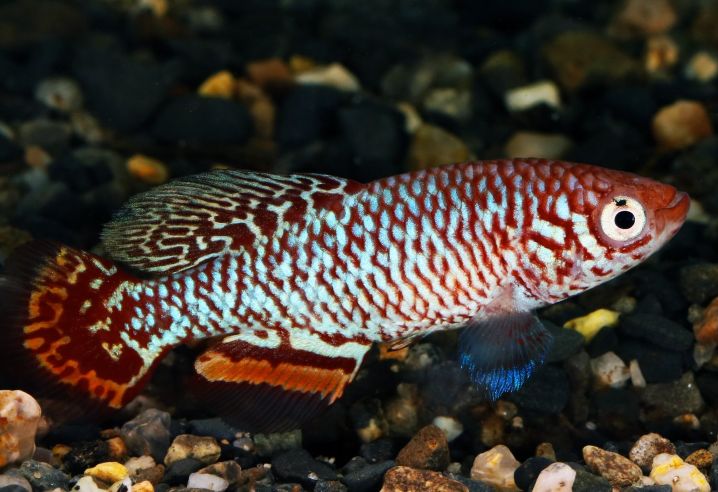
Tank mates
Keeping the notho killifish in a species tank with one male and 3-4 females in it is an ideal option in this case. If there are several males and females in one small tank, males may fight from time to time. This way, they attract the females attention.
Such fights, as a rule, don’t have any serious repercussions for both participants. In the worst-case, their fins get slightly damaged, but they heal fast.
If there are no females in the tank, males behave more peacefully.
As for their tank mates, in case dwelling a community tank, other killifish kinds will do, Endler’s guppy, guppy, pygmy cory, etc. Don’t put Nothobranchius in one tank with long-finned fishes. They will nip their fins.
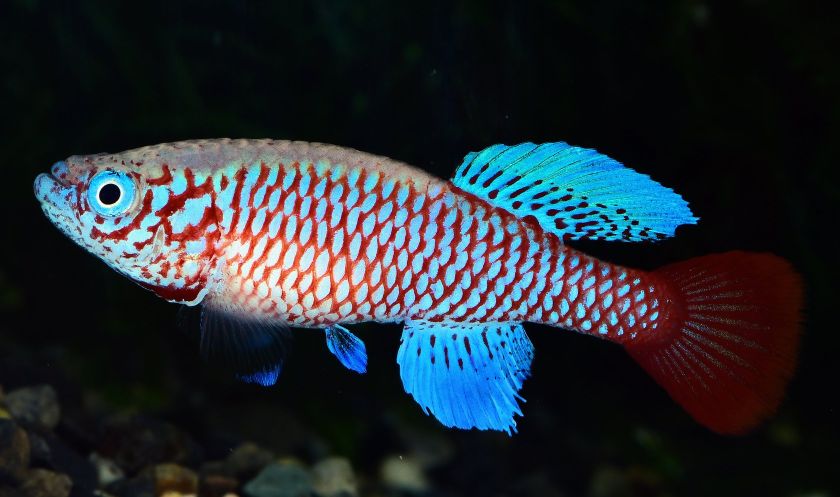
Feeding
Notho killifish has quite an intense metabolism, which requires active feeding. The best way is to feed them twice a day with small portions of food, which the fish will eat completely in several minutes.
In the wild, the notho killifish feeds on small, spineless species. In captivity, their diet may contain any live, frozen, or artificial food.
However, some of them don’t like artificial food or don’t eat it at all.
Gender differences: male vs female
The notho killifish has a rather pronounced dimorphism. Males are essentially brighter colored and larger than females. Males have vivid rich coloring, well-defined patterns, wide color palette containing surprisingly unexpected color combinations.
Females have less appealing coloring. For all notho killifish kinds, it is limited to a filbert-brown palette without bright glow and colored fin edges.
Breeding
There are no issues with notho killifish breeding. Starting from the age of 1.5-2-month-old, they lay eggs every day, even in a community tank.
However, it is more complicated to save the eggs and ensure they turn into juveniles.
A tank about 5-10 liters large will do as a spawning tank. The best tank substrate and the one for egg incubation is peat put as a layer 1 cm thick. It preserves moisture well, and it has antibacterial properties as well.
The peat should have neutral pH not to acidify the tank water. To ensure this, you should boil it for 20 minutes, wash it till the water becomes transparent, and then boil it again for 40 minutes and wash. Only after such preparation, you can put the peat into the tank.
For breeding, you can use both soft and hard water. Water pH shouldn’t be less than 6,5. Nothobranchius can successfully breed even in very hard water (dGH 20°, KH 22°) and alkaline water (pH 8).
Tank water quality is crucial. It shouldn’t contain any organic components (food remnants, products of the notho killifish life); otherwise, the eggs die.
After laying eggs, the breeders go to opposite sides, and some time later, they repeat the process. Depending on Nothobranchius kind, they may lay from several eggs to several dozens of them.
Most notho killifish kinds are comparatively fruitful (they lay up to 150-200 or even more eggs through the breeding cycle).
The tank substrate temperature and its humidity affect the eggs incubation time. If the peat is very dry, this time may essentially increase. Insignificant temperature raise and its diurnal variability decrease the dormancy time.
It is considered that if the peat with eggs is stored at the temperature of 27-29°C, you can drown it in water in six weeks. At a lower temperature, you should do this 2 or more months later.
You should check the eggs from time to time and remove the damaged ones. Eggs evolution takes from one month to a year. You can define if the eggs are ready when looking at them through the magnifying glass. If embryon eyes have a silvery tint, you should remove the peat with eggs to a tank with a water level that doesn’t exceed 3 cm.
In this regard, we should mention that the juveniles at the moment of hatching are quite tiny. Nevertheless, almost since the first hours of their lives, they can eat brine shrimp nauplius, which makes aquarist’s job significantly easier as for the juveniles start food.
Only for those Nothobranchius kinds that have extremely small-sized juveniles should you use rotifers or slipper animalcule as start food.
The juveniles grow quite fast, and it takes them just 1.5-2 months to get the adult coloring and become reproductive. Then the fishnotho killifish starts to breed actively.
Such pace of growth and evolution is due to a short rainy season during which the juveniles have not only to grow but to lay eggs as well.